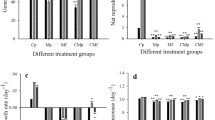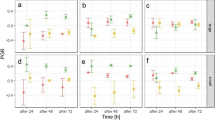Abstract
The growth rate or numerical response of five species of bactivorous ciliates to the abundance ofEnterobacter aerogenes was examined in monoxenic culture. The ciliatesColpidium campylum, C. colpoda, Glaucoma scintillons, G. frontata, andCyclidium glaucoma were isolated from a small pond. Four were grown in shaken cultures, while three were grown in cultures in which the bacteria were allowed to settle on the bottom of the culture vessel. Of the seven response curves generated, four had distinct thresholds, so that the Michaelis-Menten model usually fitted to ciliate numerical response curves was not appropriate. In shaken cultures, half-saturation prey densities ranged from 5.5 × 106 to 42.9 × 106 bacteria/ml. In unshaken cultures, half-saturation densities ranged from 0.057 × 106 to 14.6 × 106 bacteria/cm2. Two species grown on both suspended and settled bacteria attained higher growth rates and had lower half-saturation prey densities feeding on settled bacteria.
Similar content being viewed by others
References
Ashby, R. E.: Long term variations in a protozoan chemostat culture. J. Exp. Mar. Biol. Ecol.24, 227–235 (1976)
Berk, S. G., R. R. Colwell, and E. B. Small: A study of feeding responses to bacterial prey by estuarine ciliates. Trans. Am. Microsc. Soc.95, 514–520 (1976)
Bott, T. L.: Nutrient cycles in natural systems: Microbial involvement. In: J. Tourbier and R. W. Pierson (Eds.): Biological Control of Water Pollution, pp. 41–42. University of Pennsylvania Press, Philadelphia (1976)
Canale, R. P., T. D. Lustig, P. M. Kehrberger, and J. E. Salvo: Experimental and mathematical modelling studies of protozoan predation on bacteria. Biotechnol. Bioeng.15, 707–728 (1973)
Contois, D. E.: Kinetics of bacterial growth: relationship between population density and specific growth rate of continuous cultures. J. Gen. Microbiol.21, 40–50 (1959)
Curds, C. R., and A. Cockburn: Continuous monoxenic culture ofTetrahymena pyriformis. J. Gen. Microbiol.66, 95–108 (1971)
Dive, D.: Influence de la concentration bactérienne sur la croissance deColpidium campylum. J. Protozool.22, 545–550 (1975)
Drake, J. F., and H. M. Tsuchiya: Predation onEscherichia coli byColpoda steint. Appl. Environ. Microbiol.31, 870–874 (1976)
Drake, J. F., and H. M. Tsuchiya: Growth kinetics ofColpoda steini onEscherichia coli. Appl. Environ. Microbiol.34, 18–22 (1977)
Endrenyi, L.: Statistical problems of kinetic model building. Symp. Biol. Hung.18, 11–30 (1974)
Endrenyi, L., and F. H. F. Kwong: Design and analysis of hyperbolic kinetic and binding experiments. In: H. C. Hemker and B. Hess (Eds.): Analysis and Simulation of Biochemical Systems, pp. 219–237. North-Holland, Amsterdam (1972)
Hamilton, R. D., and J. E. Preslan: Observations on the continuous culture of a planktonic phagotrophic protozoan. J. Exp. Mar. Biol. Ecol.5, 94–104 (1970)
Harding, J. P.: Quantitative studies on the ciliateGlaucoma. I. The regulation of the size and fission rate by the bacterial food supply. J. Exp. Biol.14, 422–430 (1937)
Holling, C. S.: The functional response of predators to prey density and its role in mimicry and population regulation. Mem. Entomol. Soc. Can.45, 1–60 (1965)
Jannasch, H. W.: Steady state and the chemostat in ecology. Limnol. Oceanogr.10, 716–720 (1974)
Jost, J. L., J. F. Drake, A. G. Fredrickson, and H. M. Tsuchiya: Interactions ofTetrahymena pyriformis, Escherichia coli, Azotobacter vinelandii, and glucose in a minimal medium. J. Bacteriol.113, 834–840 (1973)
Jost, J. L., J. F. Drake, H. M. Tsuchiya, and A. G. Fredrickson: Microbial food chains and webs. J. Theor. Biol.41, 461–484 (1973)
Laybourn, J. E. M., and J. M. Stewart: Studies on consumption and growth in the ciliateColpidium campylum Stokes. J. Anim. Ecol.44, 165–174 (1975)
Lehman, J. T.: The filter feeder as an optimal forager, and the predicted shapes of feeding curves. Limnol. Oceanogr.21, 501–516 (1976)
Pianka, E. R.: On r- and K-selection. Am. Nat.104, 592–597 (1970)
Proper, G., and J. C. Garver: Mass culture of the protozoaColpoda steini. Biotechnol. Bioeng.8, 287–296 (1966)
Rasmussen, L.: Nutrient uptake inTetrahymena pyriformis. Carlsberg Res. Commun.41, 143–167 (1976)
Sieburth, J. M.: Bacterial substrates and productivity in marine ecosystems. Annu. Rev. Ecol. Syst.7, 259–285 (1976)
Steele, J. H.: The Structure of Marine Ecosystems. Harvard University Press, Cambridge, Mass. (1974)
Sudo, R., K. Kobayashi, and S. Aiba: Some experiments and analysis of a predator-prey model: interaction betweenColpidium campylum andAlcaligenes faecalis in continuous and mixed culture. Biotechnol. Bioeng.17, 167–184 (1975)
Taylor, W. D., and J. Berger: Growth ofColpidium campylum in monoxenic batch culture. Can. J. Zool.54, 392–398 (1976)
Taylor, W. D., and J. Berger: Growth responses of cohabiting ciliate protozoa to various prey bacteria. Can. J. Zool.54, 1111–1114 (1976)
Villarreal, E., R. R. Canale, and Z. Akcasu: Transport equations for a microbial predator-prey community. Microb. Ecol.3, 131–142 (1977)
Author information
Authors and Affiliations
Rights and permissions
About this article
Cite this article
Taylor, W.D. Growth responses of ciliate protozoa to the abundance of their bacterial prey. Microb Ecol 4, 207–214 (1977). https://doi.org/10.1007/BF02015077
Issue Date:
DOI: https://doi.org/10.1007/BF02015077




